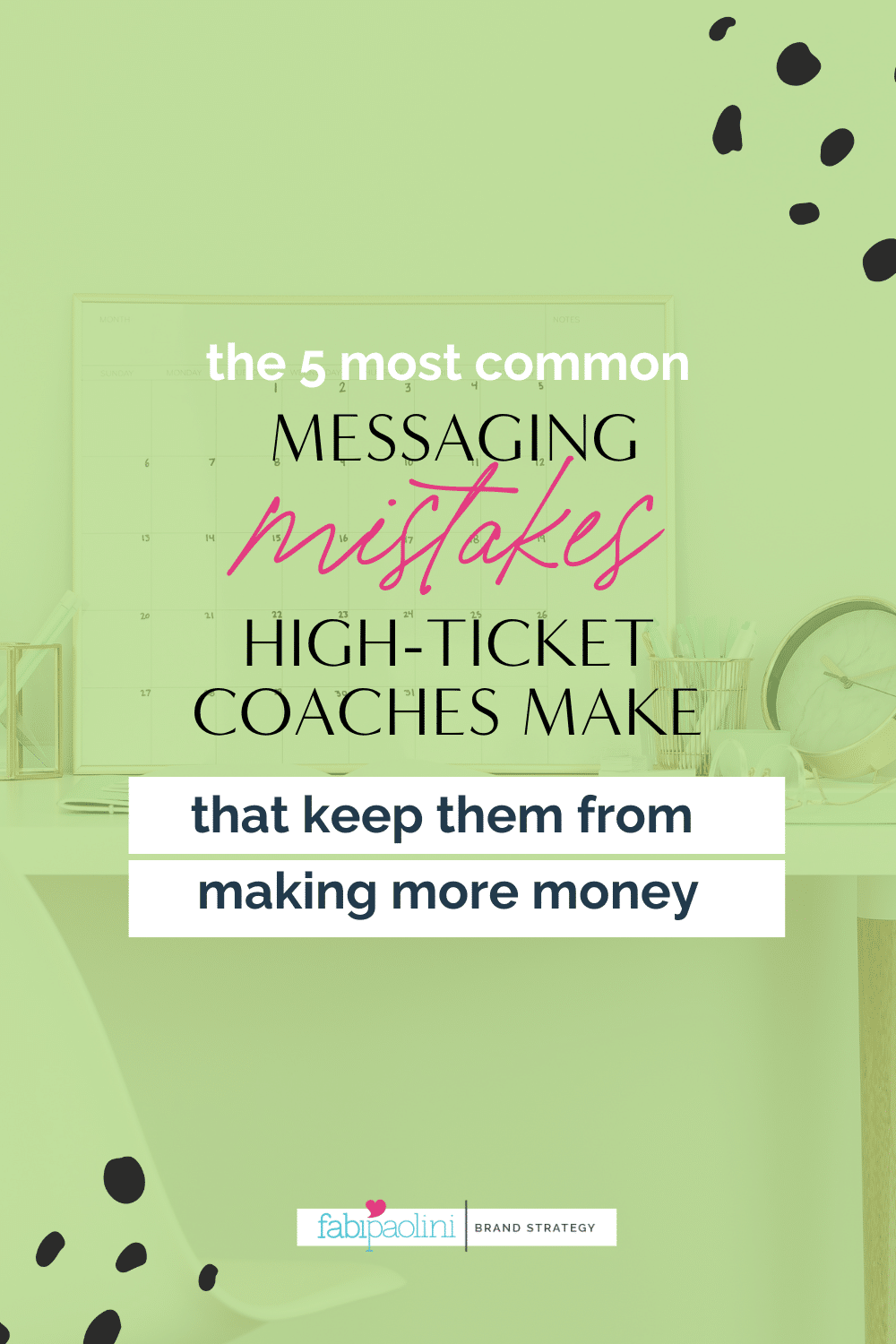Mastering High-Ticket Messaging: 5 Mistakes To Avoid If You Want To Attract High-Ticket Clients
It’s an all-too-common scene in the world of high-ticket coaching: talented professionals, armed with transformative skills and deep insights, yet struggling to attract the caliber of clients their expertise deserves.
This disconnect often stems not from a lack of ability, but from a critical oversight in messaging.
When your message misfires, it doesn’t matter how exceptional your coaching methods are—the right clients simply won’t hear you.
So let's talk about the top five messaging mistakes even seasoned coaches make and offers strategic insights to refine your communication, ensuring it resonates with—and attracts—your ideal high-ticket clients.
Messaging Mistake #1: Misunderstanding the Audience’s Real Problems
One of the most significant barriers to successful high-ticket messaging is the failure to grasp the true concerns of your audience. Many coaches approach communication as a showcase of their solutions, inadvertently overlooking the actual problems and aspirations of their prospective clients.
To put it simply: most people don't TRULY understand what their audiences' problem is. They tend to communicate too much based on the actual solutions offered instead. But the thing is, people will buy when they feel like what you do solves their problem.
I often ask my clients, how can you say 'overwhelm' without using the word 'overwhelm'? How can you get better at painting a clear picture on what the problem looks like for your audience? When you master this, you get better at high-ticket messaging.
To make sure your messaging resonates with high-ticket clients, it's crucial to delve deep into their actual problems and needs. Here are some strategies to refine your approach:
- Listen Actively: Engage in conversations with potential clients to understand their challenges deeply. Use social listening tools to monitor discussions in your industry.
- Empathy Mapping: Create empathy maps to visualize your clients' day-to-day experiences and emotional journeys. This can help tailor your messages to their actual states of mind.
- Simplify Your Language: Avoid jargon and complex terms that might alienate potential clients. Instead, use clear, relatable language that speaks directly to their needs.
- Highlight Immediate Benefits: While long-term goals are important, emphasize how your coaching can provide immediate relief and tangible improvements in their personal or professional lives.
By incorporating these strategies into your high-ticket messaging, you ensure that your communications not only capture the attention of potential clients but also speak directly to their hearts and minds.
You want to make sure that your message is really doing a great job at speaking to their specific problems and needs.
Messaging Mistake #2: Over-agitating the problem
Want to learn how to MASTER High-ticket messaging? I'm hosting a live event walking you through the details how. Click below for more details.
Messaging Mistake #3: Lacking a Clear and Compelling Core Message
A common mistake in high-ticket messaging is NOT really understanding the difference between 'copy' and 'messaging'.
Messaging is the overarching theme you stand for. What you want to be known for. What you ACTUALLY sell.
Copy are the words that express these ideas.
In other words - people end up failing to clearly articulate a clear and compelling core message.
Many coaches and consultants invest in a ton of marketing strategies—but without a cohesive core message, these resources fall short in converting leads to high-ticket sales.
To develop a resonant and effective core message, integrate the following strategies:
- Define Your Angle of Mastery: Identify and articulate your unique perspective or methodology in your field. This is your 'Angle of Mastery'—the specific approach you use that sets you apart from others and directly addresses your target audience's needs.
- Ensure Consistency Across Platforms: Your core message should be consistently reflected across all your marketing channels. This builds a strong, cohesive brand identity that your audience can easily recognize and connect with.
- Incorporate Emotional Resonance: Engage your clients on an emotional level by focusing on the transformational journey your coaching provides. Highlight the emotional outcomes and personal breakthroughs that your unique approach facilitates.
By focusing on your Angle of Mastery and presenting a clear, impactful core message, you solidify your positioning in the market and enhance your ability to attract and retain high-ticket clients who are looking for exactly what you have to offer.
Messaging Mistake #4: Lacking a Clear and Compelling Core Message
Another major mistake? Not really understanding what VALUE actually is.
Coaches are either:
A. Over-giving, over-teaching and turning their content into an encyclopedia - where they sound like and compete directly with every other person in their niche.
or
B. They avoid giving away the how...and focus their content ONLY on the 'What and the Why'. Which means it all sounds vague and doesn't give clear insight on what you do.
In truth, delivering value looks like shifting perspectives. Giving your audience Lightbulb moments that show people what makes you TRULY unique and why your Angle of Mastery or your approach is different from other things they have tried before.
For this you want to:
- Focus on Transformation, Not Information: Emphasize how your services lead to significant changes in your clients' personal or professional lives. Highlight transformations and outcomes rather than just the educational content.
- Create Actionable Insights: Provide content that not only educates but also gives clients the tools to take clear, actionable steps towards their goals.
- Utilize Storytelling: Share success stories and testimonials that demonstrate the real-world impact of your coaching. Stories resonate more deeply than facts alone and can illustrate the tangible benefits of your approach.
- Offer Unique Insights: Deliver perspectives and insights that clients can’t find elsewhere. Your unique viewpoint can help shift their thinking and present solutions in a new light, adding immense value.
Messaging Mistake #5: Failing to Align Messaging with Authentic Self
This is a MAJOR one. It has to do with selling things that don't feel truly aligned or authentic to who we are and what we believe in.
Coaches make this messaging mistake ALL THE TIME. They think that they need to make their offer more tangible, so they turn to results or outcomes in their marketing that don't feel or sound authentic or real to them at all. And it shows.
They either feel like something is off...or their audience does.
This misalignment can create a sense of inauthenticity that potential high-ticket clients can sense, often subconsciously. When clients perceive a disconnect between your message and your authentic self, it undermines trust and diminishes the likelihood of them committing to your high-ticket offers.
Authenticity in messaging extends beyond simply being true to oneself; it's a foundational element that influences the quality and depth of the relationships coaches build with their clients. When coaches communicate authentically, they do more than just convey information; they reveal their genuine values, beliefs, and personality. This transparency allows potential clients to see and understand who the coach truly is, not just professionally, but on a personal level as well.
Here’s why this matters:
-
Shared Values and Visions: Clients are more likely to engage with a coach whose values resonate with their own. For example, if a coach genuinely values holistic growth and communicates this authentically, they will attract clients who prioritize comprehensive development over quick fixes. This shared value system helps to establish a strong relational foundation built on mutual understanding and respect.
-
Trust Building: Authenticity contributes significantly to trust-building. When clients feel that a coach is being honest and open about who they are and what they stand for, it reduces the clients' fears of being misled or disappointed. Trust is especially crucial in high-ticket coaching, where clients make significant emotional and financial investments based on the belief that the coach can lead them to their desired transformations.
-
Long-Term Engagement: Clients who feel a deep connection with their coach's authentic message are more likely to commit to longer-term engagements. These clients believe not only in the coach's methods but also in their overarching philosophy and approach to life and business. This alignment can lead to more sustained and fulfilling coaching relationships, which are beneficial for both the client and the coach.
-
Emotional Resonance: Authentic messaging resonates on an emotional level, which is often more compelling and memorable than factual or technical communication. When clients encounter a coach who shares their fears, hopes, and dreams openly, they feel emotionally engaged. This engagement is powerful because clients are more likely to commit to a service that feels emotionally satisfying and aligned with their innermost desires.
Elevating your high-ticket messaging
Navigating the nuances of high-ticket messaging is no small feat, yet mastering this art is crucial for any coach aiming to elevate their practice and attract the right clients. By recognizing and rectifying these common messaging mistakes—from misunderstanding client needs to failing to align your message with your authentic self—you set the stage for more meaningful engagements and sustainable success.
Remember, effective messaging is not just about broadcasting what you offer; it's about resonating with your audience on a deeper level, understanding their aspirations, and speaking directly to their hearts. As you refine your approach, focus on clarity, empathy, and authenticity. This will not only help you stand out in a crowded market but will also attract clients who are genuinely aligned with your vision and values.
So take a moment to reflect on your current messaging strategies. Are they truly serving you and your audience? If not, consider this your call to action. Revamp your communications with these insights, and watch as your coaching practice transforms, attracting not just more clients, but the right clients—those who are ready and eager to invest in the high-ticket journey you offer.
By committing to continuous improvement and staying true to your core message, you'll build not only a successful coaching business but also a legacy of transformation and growth.





